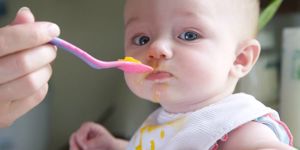Weaning is the stage in infancy when you start introducing solid foods alongside your baby's milk requirements. The advice is not to start offering solids until your baby is around 6-months old, unless told otherwise by your health visitor or GP. At this age, their usual milk is still a vital part of their nutrition and should continue to until 12-months at least. But like we say, every baby is different, and you need to trust your instincts on when it is right for your little one once they've reached the 6-month mark52.
Signs to Start:
- Can sit up well without support.
- Is developing a ‘pincer’ grasp.
- Is keen to participate at mealtimes and are ready or willing to chew.
- Doesn’t automatically push solids out of their mouth with their 'tongue-thrust' reflex.
Things You’ll Need
- Highchair - upright and safely strapped.
- First cup - to sip water with their meals from open cups or free-flow cups.
- Spoons - rubber or plastic weaning spoons are ideal.
- Plastic bowls - you can get them with a suction base to keep them on the table.
- Ice cube trays - great for batch cooking small portions.
- Bibs - wipeable ones with sleeves are best at keeping baby mess-free.
- Wipable mat - for the 'splash zone' around your baby's highchair.
Which Method is Best?
As you begin your research into this next stage of your baby’s development, you’ll no doubt come to learn about the different approaches to weaning such as ‘baby-led weaning’ (BLW) or ‘puréeing’, known as 'traditional weaning'.
Put simply, a baby-led approach to introducing solids, is where you allow the baby to feed itself with small cuts of food. It means that food needs to be cut into chip-shaped portions so that the baby can hold it, such as cucumber sticks, tortilla, mango slices, or toast soldiers. You can even feed them anything off your own dinner plate to introduce them to a variety of textures, tastes and colours, usually making for less fussy eaters.
A more traditional weaning method is puréeing, which involves spoon-feeding the baby puréed food. This requires more preparation beforehand, such as steaming and mashing softer foods.
Neither is the ‘correct’ way of weaning, you can choose either to suit you and your baby's needs. Some families prefer to buy pre-made pots or blend vegetables at home, others prefer to cook one meal for everyone and separate a tiny, cut up portion for their little one for ease. It’s a completely personal preference.
How To Get Started
It's likely best to start at early dinner time or around lunchtime when baby is not too tired and will likely be less fussy. Weaning can take some time to introduce, so don't rush it - go at a pace that suits you both - after all, it's a whole new skill for baby to learn.
It’s worth noting that when you start weaning, most of their food will go on the floor rather than in their mouth, so make sure to put a mat down.
Each food has its own unique flavour and texture that baby will need to get used to, so it can take time for them to settle into weaning. Some days, they might scoff their meal, others, it may end up all on the floor, but don't worry, this is entirely normal and nothing to worry about. Make sure their other feeds (breast or bottle) supplement any food they don't eat when weaning and be patient.
Introduce 1 or 2 new foods at a time and pace it, they don't need a full roast dinner on day 1. Pretty soon they'll be eating off your plate!
When cleaning up baby's messy dinner time, be sure not to wipe their face too vigorously as it can make your baby dribble more. It is best to dab their chin instead, so the reflex that stimulates salivary production isn't triggered. It's messy enough as it is, even without the extra drool!





